

 |
September 20 - October 4, 1986: Two Weeks in Europe |
 |
Return to the Index for 1986 |
The first half of 1986 didn't present any picture-taking opportunities; Grant was absorbed in his job with Senco, until he changed jobs in September and went to work for Anderson and Associates, a contract furniture showroom in the World Trade Center over on Stemmons expressway. He seems pleased to be working with furniture again. For my part, I continued to travel and teach, going mostly to places not known for being tourist destinations (which is why there are no pictures of those places).
In August, though, an assignment in Europe was given to me; it would be three weeks of classes for NATO. The first week would be in Oslo, Norway, and the other two weeks would be in Mons, Belgium. These would be picture-taking opportunities, so I took my camera. Unbeknownst to me, though, the camera began to malfunction shortly after I arrived in Norway, and a good many of my pictures from this trip did not turn out very well. So on this album page and the next, you'll find the quality of the pictures not as good as they have been.
Getting to Oslo and the Norum Hotel
|
I wanted to arrive in Oslo on Saturday, rather than Sunday, so I could get acclimatized and have a day for sightseeing as well. So Steve put me first on an overnight flight from DFW to London.
I am starting to build up a significant number of miles in American's new AAdvantage frequent flyer program, and I have reached the first elite level, so I like to fly them whenever I can (as I get better treatment).
|
At Heathrow, I I connected to Scandinavian Airlines (one of American's partners in its worldwide program); the flight went first to Amsterdam and then on to Oslo, with one short stop in the town of Stavanger on the southwest coast of Norway.
Stavanger is Norway's third-largest urban area, and it is located on the Stavanger Peninsula in Southwest Norway. The city was founded in 1125, the year the Stavanger Cathedral was completed. Unlike most cities today, Stavanger's core is to a large degree 18th- and 19th-century wooden houses that are protected and considered part of the city's cultural heritage. This has caused the town centre and inner city to retain a small-town character with an unusually high ratio of detached houses.
The city has grown rapidly in recent years, primarily a result of Norway's booming offshore oil industry. Norway's largest company, the energy company Statoil is headquartered in Stavanger. I am going to be working at a NATO installation outside Oslo; Stavanger is also home to NATO's Joint Warfare Center.
When I arrived in London, the weather, which had been fairly warm in Dallas, had turned decidedly cooler, but when the plane landed in Stavanger, I could tell that the weather was cooler still. Finally, landing in Oslo, I found I needed my jacket. The temperature stayed in the 60s throughout my stay, and the weather was overcast most of the time.
|
I had gotten a map of Oslo at the little bookstore at the airport, and had located it on the map, so when the shuttle took me into town, I kind of knew where it was headed. The Hotel Norum turned out to be right in the city center, about a ten- or fifteen-minute walk from just about everyplace.
I spent the afternoon walking around the area by the hotel, and walked down to the city center for dinner that night. I have gone to look for some information I can include about the Norum, but they don't have a website it seems. I did find out that the hotel became part of a larger chain sometime after my stay this year; it is now the Frogner House Norum Hotel, if you want to look it up.
I was very tired after the overnight flight to London, and traveling most of the day to get to Oslo, so I really didn't want to try to do much sightseeing today; that's what tomorrow will be for.
|
The Norum is an older hotel, built, I think, in the early part of this century. For a long time, Oslo was not much of a tourist destination, so the chain hotels didn't build here, and hotels like the Norum had all the business. Now, however, you can find everything from a Sheraton to a Hilton, but the NATO people still stay here. There is a convenient bus right to the NATO compound, and since the NATO people recommended the hotel, we feel constrained to stay there, even though there are newer, more luxurious and more expensive hotels further downtown.
As you can see, the room is quite plain. Their version of a queen size bed is one bed with two narrow mattresses that don't connect. The electric service was obviously added at a time after the hotel was built, since all the wiring is outside the walls. There is no television, although what I would do with Norwegian TV is beyond me, at least it would be something to have on for background.
I did find out a day later that there was an English-language channel, SkyChannel, and that the hotel has small televisions available for guests that want them, and I did pick one up at the desk. SkyChannel was mostly news and British shows, but it provided a bit of entertainment and background.
|
In the two pictures I took, you can see all of the room, save for the small bathroom near the door. I was about four flights up, and there was a little elevator- good for three or four people at the most- or you could use the stairs (which I did most of the time).
(I have noticed in the pictures I have found of the hotel's rooms today that they now, like almost every hotel anywhere, have flat-screen televisions in their rooms.)
On the other side of the room there was another small table, and two more chairs. There is a telephone, but I have been cautioned against using it to call home, since most European hotels add a hefty surcharge to any calls made with their phones. Sometimes, the surcharges can multiply the cost of the call by a factor of ten or more. There are no ice machines or vending machines, although I can get small amounts of ice from the dining room. The Norum, like most European hotels, serves a full breakfast that is included with the room, with just about everything you can think of, with the emphasis on Norwegian products, like fish. All in all the breakfast is quite good, and if I were more of a breakfast person, I could make a big meal out of it.
Two or three days I couldn't resist the breakfast buffet, and got up early enough to have a full breakfast before the shuttle bus out to the NATO installation arrived. Other days, I chose to take some fruit or a few of the packaged items to eat at lunch.
A Sunday Excursion Around Oslo
|
I got up early on Sunday and went down through the lobby for my tour of Oslo. Anyplace in the US, the Norum would probably be the oldest building in town, but here it fit right in with the rest of the entire neighborhood. Down the street to the right were a number of small restaurants and neighborhood stores and shops, including a laundry where I did my shirts and things for the next week on the Continent. The Norum had a small lobby, but such oddities as a room on the second floor with a piano and places to sit and listen. No one was ever playing it that I could tell, but I sat down a few times without any audience and played for myself. The hotel was not air-conditioned, but then it was not very warm at this time of year. The bus to NATO stopped right in front of the building. The architecture of the hotel is really interesting, and would be quite a standout anyplace but here.
I had arrived in Oslo on Saturday so that I could spend Sunday wandering around the city, and I got an early start so I could see as much as I could; I had no idea when I might be in Scandanavia again (as it turned out, this would be 22 years hence).
Around the Norum Hotel
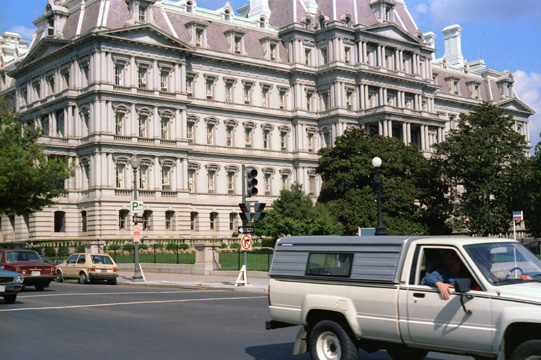 The Norwegian Parliament Building In Oslo, there are plenty of buses and electric trolleys, but mostly I walked around the city. This building, another classic example of the style of construction in Oslo, houses the Norwegian Parliament and is connected to the residence of the King of Norway. The area in front of the building is a very pretty park. |
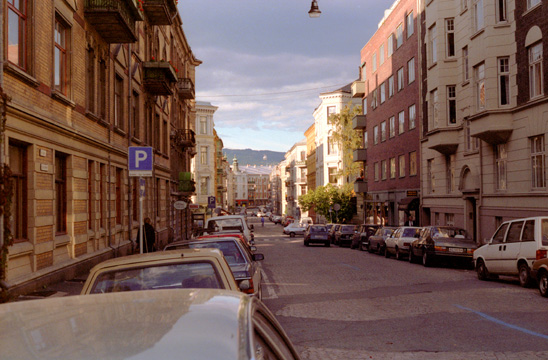 A Typical Residential Street The city is full of areas like this, where the building are mainly apartments, and there are lots of little shops to serve the needs of the neighborhood residents. The area reminded me of Chicago; like Chicago, there isn't much parking except what you can find on the street. Off in the distance are the mountains that surround Oslo. |
Frogner Park/The Vigeland Sculpture Park
|
Around one square kilometer remained when the City of Oslo bought the property in 1896 to secure space for further urban development. The municipal government decided around 1900 to make a park for recreation and sports. Frogner Stadium was opened near the road and the area near the buildings was opened to the public in 1904. Norwegian architect Henrik Bull designed the grounds and some of the buildings erected in Frogner Park for the 1914 Jubilee Exhibition.
The municipal government subsequently decided that Gustav Vigeland's fountain and all his monuments and statues should be placed in the park. The area was ready for Gustav Vigeland fountain in 1924 and the final plan was released in 1932 by the city-council. Most of the statues depict people engaging in various typically human pursuits, such as running, wrestling, dancing, hugging, holding hands and so on. However, Vigeland occasionally included some statues that are more abstract, including one statue, which shows an adult male, fighting off a horde of babies.
Frogner Park is the largest park in Oslo and covers about 125 acres; the sculpture installation is the world's largest sculpture park made by a single artist. Frogner Park is the most popular tourist attraction of Norway, with between 1 and 2 million visitors each year, and is open to the public at all times.
|
The Vigeland installation, originally called the Tørtberg installation, is located near the present centre of Frogner Park. It is the name of the arrangement of sculptures and not of an area as such, although tourists and maps often refer to the area as "Vigeland Park", a name rarely used in Oslo and considered inaccurate.
The sculpture area in Frogner Park covers 80 acres and features 212 bronze and granite sculptures all designed by Gustav Vigeland. In 1940 the Bridge was the first part of the Sculpture Park to be opened to the public. 58 of the park's sculptures reside along the Bridge, which is over three hundred feet long and about 50 feet wide. It serves as the connection between the main gate and the lawn just inside it and the Fountain.
All the sculptures are clad in bronze and contribute to the Human Condition theme of the park. One of the park's more popular statues, Angry Boy, was originally placed here, but is now located elsewhere. The bridge was one of the first elements of the park opened to the public, so visitors could enjoy the sculptures while most of the park was still under construction. At the end of the bridge lies the Children’s Playground, a collaboration of eight bronze statues, all in the likenesses of children at play.
At the highest point in Frogner Park lies the park's most popular attraction, The Monolith (which you can see in the distance in a picture above). Construction of the massive monument began in 1924 when Gustav Vigeland himself modeled it out of clay in his studio in Frogner. The design process took him ten months, and it is speculated that Vigeland had the help of a few sketches drafted in 1919. The model was then cast in plaster. I left the park and decided to take a local train further out northwest to the site of the 1952 Winter Olympics. On the way to the station, I took another picture of an Oslo neighborhood street, although the picture turned out much darker than I intended.
Holmenkollbakken
|
At the top of the mountain there was a snack bar and some facilities, including a gift shop, and great views of the countryside.
The 1952 Winter Olympics took place here and at other locations around Oslo. Discussions about Oslo hosting the Winter Olympic Games began as early as 1935; the city wanted to host the 1948 Games, but World War II made that impossible. Instead, Oslo won the right to host the 1952 Games in a contest that included Lake Placid in the United States. All of the venues were in Oslo's metropolitan area except for the alpine skiing events, which were held at Norefjell, about 70 miles from here. Oslo's games were the first where the host city built an "athlete's village" that was used for other purposes after the games concluded.
The Games attracted 694 athletes representing 30 countries, who participated in four sports and 22 events. Japan and Germany made their returns to winter Olympic competition, after being forced to miss the 1948 Games in the aftermath of World War II. Germany was represented solely by West German athletes because East Germany declined to compete as a unified team. Portugal and New Zealand made their Winter Olympic debuts, and for the first time women were allowed to compete in cross-country skiing. Norway dominated the overall medal count with 16 medals, seven of them gold. The Games closed with the presentation of a flag that would be passed from one Winter Olympics host city to the next. The flag, which became known as the "Oslo flag", has been displayed in the host city during each subsequent Winter Games.
|
|
More upgrades were made when Oslo bid for the FIS Nordic World Ski Championships 1966, the take-off slope was moved back to allow for longer jumps, new concrete stands were built, and the tower was made taller. Another major reconstruction occurred in 1975, and the jump facility took on the form it has today. Throughout the late 1970s improvements were made in the electronic measurement systems, as well as lighting and audio systems, but these where more or less invisible.
In the off season, like now, you can pay a fee and go to the top of the ski jump where there are good views of the surrounding area. The fee was small and it turned out that the views were well worth it. Here are some of them:
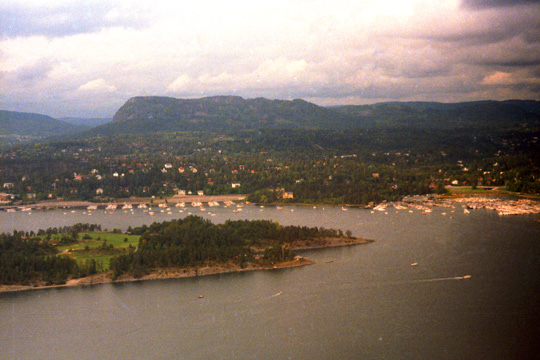 The Head of the Skagerrak Fjord Oslo is built at the end of a large, wide fjord, which provides access to the sea and makes Oslo a protected seaport. At the back here, the fjord widens out into a large bay, and there are a lot of boats it seems. This shot looks North. I imagine this is very pretty on a sunny day. |
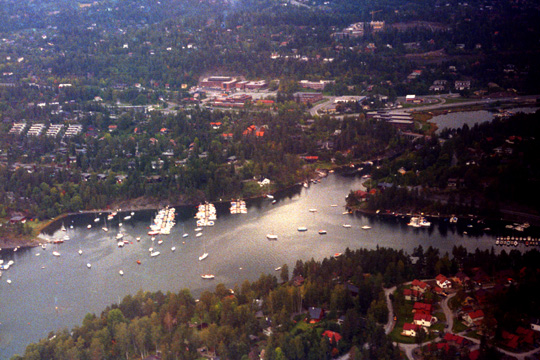 The Very End of the Fjord Down there you can see a lot of private boats and a marina. On an afternoon later in the week I took a bus that takes you to the shores of the fjord, very near the marina that you see here. The area reminded me of Muskegon in the Fall, except for the mountains. This whole area Northwest of Oslo is residential. |
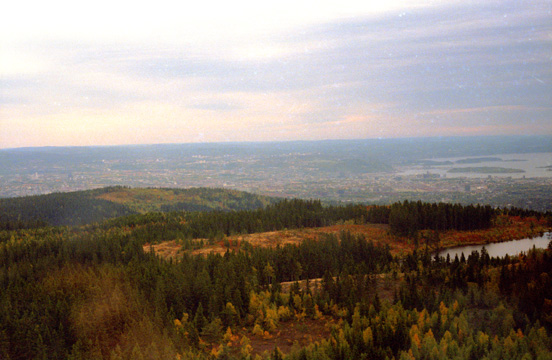 Looking Southwest Across Part of Oslo I am still on the the top of the ski jump at Holmenkollbakken. |
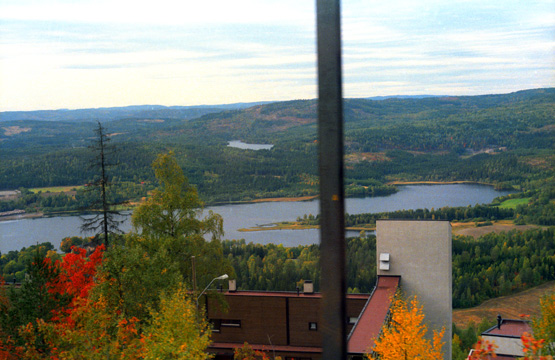 A Lake in the Mountains Overlooking Oslo I am back at what would correspond to a visitor center for these mountains. This shot looks South, and shows a small lake that has formed up here. |
 Southwest Across the Mountains Around Oslo Outside of the cities and towns, Norway is pretty desolate, but beautiful. Perhaps it is something like Alaska. |
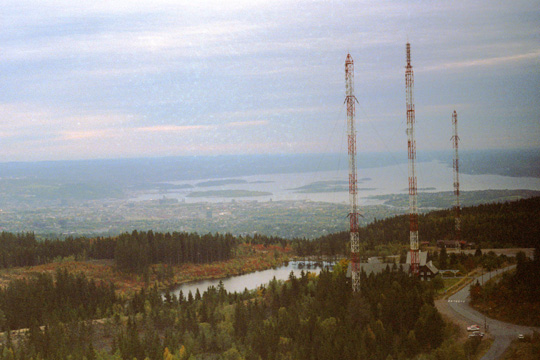 Another View of the Mountaints Around Oslo You can see the road through the facilities up here, and some transmission towers. I would imagine they are part of the main communication facilities for Oslo. |
It was getting late in the afternoon up here, and getting quite chilly, so I thought I would head back to the hotel and then decide where to go for dinner. I caught another bus back down the mountain, and then a return train back into Oslo. Here is a view from the train as we came back into Oslo. I didn't encounter a lot of people today, but I enjoyed seeing parts of the city. I had dinner at a little cafe downtown; there were, actually, a lot of people out in the center city. And I began my class the next day.
An Afternoon Excursion to Oslo's Harbor
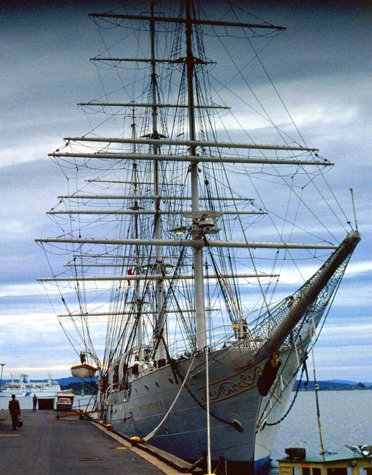 |
(Picture at left) This was a replica of an old sailing ship docked near the center of Oslo, Norway. Since getting together with Grant, I have been much more attuned to boats and boating and try to take pictures of the various boating areas that I might see on my travels. I know that these pictures interest Grant. I am not sure if this particular ship, or ones like it, were part of the "tall ships" flotilla that participated in the bicentennial.
(Picture at right)
|
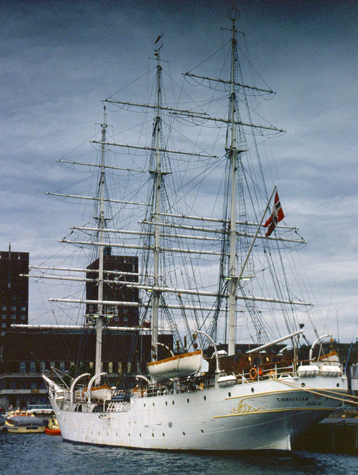 |
|
|
I think it is interesting that the boats and sailboats here are all much more sturdy-looking than the ones that I usually see around Dallas, particularly at Lake Ray Hubbard. I suppose that is because the weather here is so much more demanding.
As the weather got more overcast and the afternoon wore on, I took one final picture of the Oslo harbor. This is right at the edge of a marina area, with private boats in the foreground and some commercial shipping in the background. I enjoyed walking around Oslo, and indeed I enjoyed my week here. But tomorrow I will leave for my next two weeks of classes in Belgium.
You can use the links below to continue to another photo album page.
 |
September 20 - October 4, 1986: Two Weeks in Europe |
 |
Return to the Index for 1986 |